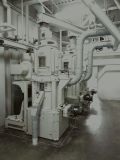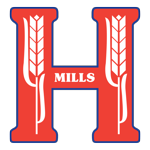Durum Flour Milling Process

Upon arrival at the mill, a wheat sample is taken to the mill's laboratory where it is checked for Protein, Moisture, Test Weight, Ash and falling number. Canadian Durum Wheat is the cleanest in the world, however, after arriving at the mill it has to be cleaned extensively to remove as many of the impurities as possible, some of which are picked up in grain handling systems.
Once the wheat is cleaned, water is added and allowed to sit, or temper, in bins for eight hours. This allows for easy separation of endosperm from bran. Endosperm is the inner part of the wheat kernel containing Semolina and flour. Bran is the outer layer of the wheat kernel. Tempering helps bran become sufficiently tough to avoid being unduly broken up. The wheat then goes through a debranning process, which removes a percentage of bran from the endosperm. This 2 step process, consisting of the abrasive and friction sections, requires large amounts of air for conveying and drying.
The wheat then goes to the mill. The mill involves an extensive system of light grinding, sifting and purifying to produce semolina of proper clarity and particle size. It passes through a set of corrugated rolls. For pasta, durum is milled into coarse chunks of semolina therefore, rolls are set to release coarse chunks of endosperm and minimal amounts of flour. It is then lifted pneumaticly to the top of the mill and then comes down through the sifters. A sifter may have 4 or 6 sections with each section containing 20-27 sieves. The driving mechanism is located in the centre and the sifter is suspended by groups of canes. As the product comes down through the sieve it is graded by size into 4 or 5 different streams that either go to the purifier, back to a different roller mill for further grinding, or to a flour bin.

The purifier is a machine with two sections, each section consists of oscillating layers of sieves. These layers of sieves are held in a metal frame. The frame is suspended, sloping slightly downward from the front to the tail end of the machine. Controlled air currents, drawn through the flow of material, then tratify the stock layers so the heavier endosperm particles fall through, while lighter branny materials float on top to the tail end where they are discharged to feed or further grinding. Then the endosperm particles go to semolina if they are the proper size or go to a roller mill to be ground finer.

This grinding, sifting and purifying process is repeated several times until as much semolina can be extracted as possible. Semolina is combined from different purifier streams of different granulation that must meet customer specifications, it then passes through rebolt sifters, scales and if required, vitamin enrichment is added. It then is conveyed to a storage bin.
